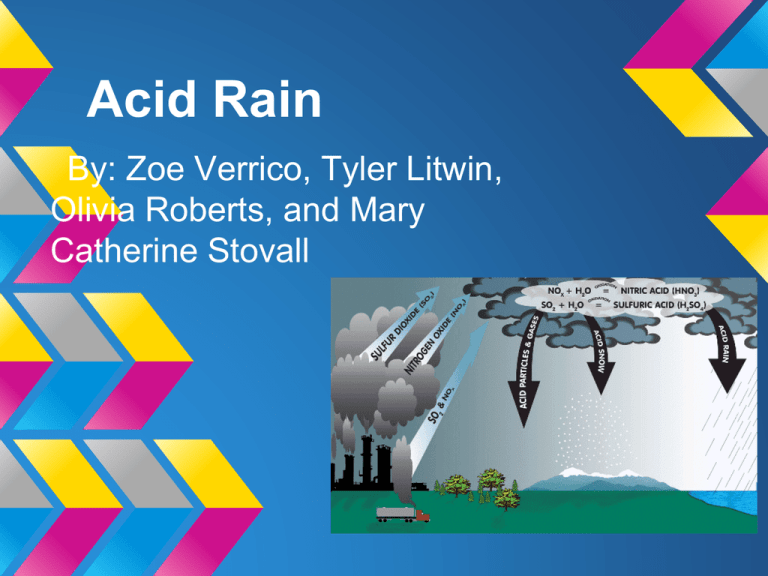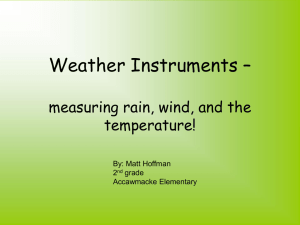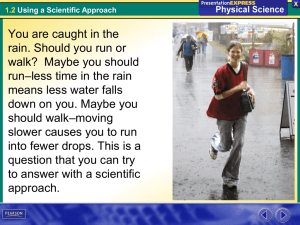Acid Rain
advertisement

Acid Rain By: Zoe Verrico, Tyler Litwin, Olivia Roberts, and Mary Catherine Stovall What is it? Acid Rain is a mixture of wet and dry deposited material in the atmosphere that contains abnormally high amounts of nitric and sulfuric acids. A dry disposition is where the glut of chemicals are incorporated into dust, smoke, and the ground. These chemicals then can remain on houses, streets, buildings, and trees, which makes them prone to runoff, ultimately carrying the chemicals into rivers, which is detrimental to the ecosystems. A wet disposition is where the chemicals in the atmosphere can be carried in the forms of fog, rain, snow, or mist. Acid rain ultimately occurs when these higher amounts of chemicals within the atmosphere mix with water, chemicals, and other materials to form compounds. What areas are affected the most? • Aquatic systems Such as... • Catskill • • Mountains and Little Echo Pond in New York Appalachian Mountains Adirondacks Why are they so easily affected? • Both the aquatic systems and mountains are the first to directly receive acid rain. Lakes, rivers, ponds, soil, and streams only have a certain buffering capacity, and become unable to neutralize the acidity of the rain. Therefore, they become acidic, which affects the aquatic How are we causing it? Acid rain is caused when a chemical reaction occurs between chemicals that have been released in the atmosphere such as sulfur dioxide and nitrogen oxides. These chemicals travel to very high points in the atmosphere where they mix with water, oxygen and other chemicals to form acidic pollutants aka acid rain. When precipitation occurs, the sulfur dioxide and nitrogen oxides mix with water and oxygen and precipitate, harming the organisms that inhabit the earth. Humans Cause Acid Rain through releasing sulfur dioxide and nitrogen oxides into the atmosphere through: power plants burning fossil fuels such as coal to create electricity exhaust from cars, trucks and buses • • • How are we causing it? (cont.) • • • • • Sulfur is found in traces of oil and coal which are burned by industrial boilers and power plants (after it is burned, it combines with oxygen to form sulfur dioxide) Sulfur Dioxide doesn't react with chemicals in the atmosphere so it travels long distances It eventually comes into contact with ozone or hydrogen peroxide and can be converted into sulfur trioxide which is easily dissolvable in water which forms sulfuric acid and becomes a part of the water cycle Nitrogen is released into the atmosphere by steam boilers and internal combustion engines Like sulfur, it also combines with oxygen to form nitrogen oxide and nitrogen dioxide Possible Outcomes if not Prevented If acid rain is not prevented or stopped, it would have a plethora of negative effects on our ecosystems and society in general. Some examples of these are surface waters such as lakes streams, aquatic animals, forests, automotive coatings, materials, visibility and human health. Possible Outcomes (cont.) • • • • • Surface Waters Acid rain flows directly into streams, lakes and marshes after falling on forests, fields, buildings and roads Acid rain participates into aquatic habitats and throw off the pH, which should be from 6 to 8 on the pH scale Acid rain mainly affects sensitive bodies of water which are located in buffer sheds whose soils have a limited buffer capacity Acid rain mainly affects sensitive bodies of water which are located in buffer sheds whose soils have a limited buffer capacity Acid rain is highly intoxicating to the plants and organisms living in these environments and could potentially destroy their ecosystems Possible Outcomes (cont.) •• Forests • • Acid rain causes slower growth, injury or death of forests In many areas of the eastern US, acid rain has caused forest and soil degradation, especially in areas of high elevation such as areas from the Appalachian mountains from Maine to Georgia which includes areas such as Shenandoah and Great Smoky Mountain National Parks In most cases, the destruction of forests is due to a mix of acid rain and environmental stressors Acid rain directly harms trees, soil and plants which destroys the ecosystems of the creatures living in it, directly harming them Possible Outcomes (cont.) •• Automotive Coatings • Acid rain directly affects automotive coatings The result of this is irregularly shaped, permanently etched areas present on the horizontal surface of a car The result of this is irregularly shaped, permanently etched areas present on the horizontal surface of a car Visibility •• Sulfur dioxide and Nitrogen Oxides contribute to visibility impairment Sulfate particles are responsible for 50 to 70 percent of the visibility impairment in national parks along the east coast and in places such as Colorado River Plateau national parks, including the Grand Canyon, Canyonlands, and Bryce Canyon Human Health •• • • The impact that acid rain has on humans isn't direct Activities such as walking into acid rain, or swimming in an acid lake isn’t any more dangerous than swimming or walking into clear water rain have no effect on humans, being that sulfur dioxide and nitrogen oxides to no harm to human health However, these gases do interact with other gases in the atmosphere and travel long distances and be inhaled deep into humans lungs However, these gases do interact with other gases in the atmosphere and travel long distances and be inhaled deep into humans lungs which causes illness, premature death from heart and lung disorders such as asthma and bronchitis What is the Environmental Impact? • • fish are killed in many bodies of water • Chronic acidification happens over a long period of time and the acid rain causes the water's acidity to rise Nutrients such as calcium are reduced • What is the Environment Impact? (cont.) • Episodic acidification happens suddenly, • • • after a large rainfall and leads to large concentrations of materials like aluminum Acid rain affects trees water and soil Acid rain water weakens the defenses of trees and plants Soil loses nutrients like calcium and magnesium Human Interferences Acid rain looks and feels like normal rain and it does not have an impact on the health of humans. However, the chemicals that cause acid rain can be harmful to humans. These pollutants are sulfur dioxide and nitrogen oxides. These pollutants cause particles to form in the atmosphere. Wind blows these particles and they are inhaled by humans. This can cause lung and heart disorders like asthma and bronchitis. Also, acid rain causes mercury to convert into methylmercury, in fish. This will raise the toxicity of the fish that humans eat. How can we help? We can help by identifying contributors to acid rain (chemicals like sulfur dioxide), then making steps to stop the contributors. Ways we could help: o o o o o Turning off lights, and other appliances Insulate homes as best you can Carpool or use public transportation Buy cars with low emissions Switch to solar, hydro, or geothermal energy. http://www.vautoinspect.com/wp-content/uploads/2012/08/How-to-reduce-carbon-dioxide-caremission.jpg Biogeochemical Cycles! • • Biological Living organisms like plants and trees take in water to photosynthesize. The acid rain then poisons the plants and damages leaves. Primary consumers eat these plants that are affected and can have bad health problems. Biogeochemical Cycles! Geological • Acid rain erodes natural rock and sediment. Man made • statues and buildings are the most affected. The sediment returns back to the ground. It also dissolves mercury in soil. Biogeochemical Cycles! • • • Chemical pH levels in lakes, rivers, and ponds rise as more acid rain comes in. Smog and dark clouds form when the sulfur and nitrogen dioxide are picked up with the water. The chemicals evaporate with the water and is carried elsewhere through the water cycle. Biogeochemical Cycles! Chemical Works Cited “Acid Rain.” Kids Corner. N.p., n.d. Web. 2 June 2013. <http://envis.tropmet.res.in/kidscorner/KidsCornerImg/acid_rain/acidrain1.gif>. “Acid Rain Car Destruction.” caradvice.com. N.p., n.d. Web. 2 June 2013. <http://www.caradvice.com.au/wpcontent/uploads/2011/05/bird-droppings-2.jpg>. Agency, US Environmental. “Effects of Acid Rain.” Acid Rain Kid’s Site. US EPA, 4 Dec. 2012. Web. 2 June 2013. <http://www.epa.gov/acidrain/effects/>. “Grand Canyon.” E-Education. N.p., n.d. Web. 2 June 2013. <https://www.eeducation.psu.edu/egee102/files/egee102/images/Lesson_04/grandcanyon.jpg>. “How to Reduce Carbon Dioxide Car Emission.” vautoinspect.com. N.p., n.d. Web. 2 June 2013. <http://www.vautoinspect.com/howto-reduce-carbon-dioxide-car-emission/>. “Industrial Boiler.” industrialboiler.com. N.p., n.d. Web. 2 June 2013. <http://www.industrialboiler.com/Portals/0/Skins/IBM/images/header.jpg>. “ira n-oil-nuclear.” greenprophet.com. N.p., n.d. Web. 2 June 2013. <http://www.greenprophet.com/wp-content/uploads/2008/11/iran-oil- nuclear.jpg>. Outer Lungs.” smm.org. N.p., n.d. Web. 2 June 2013. <http://www.smm.org/heart/Images/outerlungs.jpg>. Protection Agency, US Environmental. “Reducing Acid Rain.” Acid Rain Kid’s Site. US EPA, 4 Dec. 2012. Web. 2 June 2013. <http://www.epa.gov/acidrain/reducing/>. - - -. “What Can You Do?” Acid Rain Student’s Site. US EPA, n.d. Web. 2 June 2013. <http://www.epa.gov/acidrain/education/site_students/whatcanyoudo.html>. - - -. “What is Acid Rain?” Acid Rain Kid’s Site. US Environmental Protection Agency, 4 Dec. 2012. Web. 2 June 2013. <http://epa.gov/acidrain/what/>. Thanks For Watching :)







